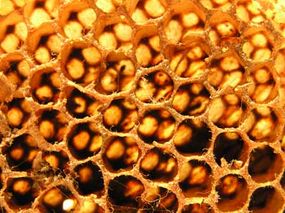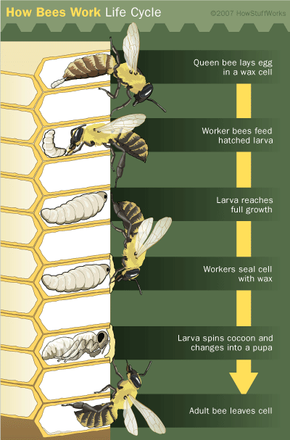The Honeycomb and Bee Reproduction
Regardless of whether they live alone or in groups, most bees have a similar approach to mating. In nearly every species, a male bee's only job is to mate with a female. Most male bees do not even have the structures necessary to make wax or carry pollen, so males in social species cannot contribute to the daily work that goes on in the hive. In fact, female honeybees usually force surviving males out of the nest before winter or when food becomes scarce.
Usually, a female bee mates with several male bees in midair, gathering all of the sperm she will need in her lifetime -- a few months for a solitary bee, or up to five years for a honeybee. Mating typically happens at a collective mating site, although scientists have not yet discovered how male bees choose a site. In some species, including honeybees, the males die shortly after mating because they leave their endophallus in the female's body, fatally injuring themselves in the process. In other species, males can mate with multiple females. Since females use sperm from several males to fertilize their eggs, this gives the male bees a better chance to father young.
Advertisement
After the female mates, she either retreats to a shelter for the winter or returns to her nest to lay eggs, depending on her species. Once she lays eggs, the eggs go through the same stages as caterpillars and butterflies do. First they hatch into larvae. The larvae eat before spinning cocoons and becoming pupae. They then emerge from the cocoons as adults.
Even though the steps are the same, the environment in which the developing bee grows can vary considerably. In solitary bees, the female builds a nest, places food inside and lays an egg. The food may include a mix of pollen and nectar called bee bread. It may also include a form of honey. Exactly how the bee positions her egg and its food varies depends on the species of the bee, as does the construction of the nest itself. Some bees lay one egg in each nest, while others divide their nests into multiple brood chambers. In nests with multiple chambers, male eggs usually go in the front, allowing young male bees to travel to the mating site before the female bees hatch. Many solitary bees seal their nests after laying eggs and never see their young. Often, these species lay eggs in the fall -- the eggs hatch in the spring, but the mother bees do not survive the winter.

Social bees, on the other hand, have a different approach to raising young. While a female solitary bee lays only a few eggs in her lifetime, a queen honeybee lays thousands. She places one egg into each cell in the brood area of the hive. The queen bee has control over whether she lays male or female eggs, and she lays male eggs in slightly larger cells. If she uses stored sperm to fertilize the egg first, the larva that hatches is female. If she leaves the egg unfertilized, the larva that hatches is male. This means that female bees inherit genes from their mothers and their fathers while male bees inherit only genes from their mothers.
Once the eggs hatch, the youngest worker bees in the hive take care of them. For the first two days of the larvae's lives, the workers feed them royal jelly. After that, the larvae eat pollen or bee bread. The only exception is the queen bee -- when the workers raise a new queen, they feed her royal jelly until she spins her cocoon. Bee larvae molt several times before spinning cocoons, at which point the workers cap their cells with tiny plates of beeswax to protect the developing brood.
The length of a female honeybee's life depends on when she emerges from her cocoon. If she emerges in the early spring, she may only live for a few weeks as she prepares the hive for lots of new bees. Workers who emerge later may live through the winter. But no matter when she is born, a female honeybee starts her life as a nurse, taking care of other bees. As she gets older, she begins to perform other important duties around the hive, such as cleaning out empty cells. She also learns to make honey and forage for food. We'll take a look at the tools that bees use to find and store food in the next section.
